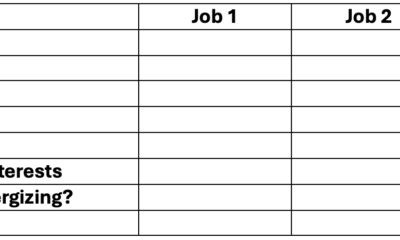Professional Development
Mapping digital transformation? Have the right strategy

The Future of Digital Transformation: Closing the Gaps for Business Leaders
The technical innovations of the past decade have been nothing short of amazing, but they are just a taste of what is to come. What are the gaps that business leaders need to close to thrive in the digital age? TSI takes a look.
Caesars Entertainment – a leading gaming company that operates many hotels, casinos and related businesses – creates special targeted offers for customers with precision. If you’ve been on one side of the casino for a while, they’ll send you a coupon for a restaurant in that section, and if you haven’t used it half an hour later, they’ll send you another coupon for a cheaper restaurant in that section. part. From personalizing your stay to determining how you will be greeted upon arrival: they use their data for everything. If you have an unlucky day, they offer you a free dinner, which can lighten your mood to sit down at the table again, otherwise you can leave and never come back.
Caesars uses technology to improve the experience not just for whales (speak for big spenders) but for a larger group of customers who make up the middle of the market – a segment otherwise missed by most in the industry.
There is no doubt that technology can improve performance. It’s a given. Technology has the power to radically transform businesses – regardless of sector or geography. However, it takes a strategist’s clear vision to wield his true power.
What does digital transformation entail? Why do even the most sincere efforts sometimes lead to disappointing results? And more importantly: when technological transformations succeed?
Barriers to Transformation
A survey of CEOs, directors and senior executives conducted by Protivit Inc. found that nearly 70% of digital transformation initiatives in 2018 failed to achieve their intended goals. Moreover, of the $1.3 trillion spent on technology transformation that same year, as much as $900 billion was lost.
Much of the success or failure of digital transformation efforts lies in the thinking. Those who transform quickly and successfully see technology not as a problem to keep up with, but as an opportunity to transform and achieve much better results.
Break down these two mental barriers to bridge the gap between “where you want to be” and “where you are.”
“If it ain’t broke, don’t fix it” Attitude
Digital transformation is often an afterthought for companies. They wait to act unless it becomes absolutely necessary. They may first want to be sure about the need for action, or they may believe that changes along technological lines are not for their sector, but for others. Then some may lack the leadership to bring technological innovation, or privacy may be their excuse for inaction.
Whatever the reason, competitors are always waiting as they look for justifications not to take action.
The result? They’re left with basic digital capabilities – framed in the aftermath of a life-or-death situation for the business – and unable to make a holistic impact amid their “if it ain’t broke, don’t fix it” mentality. attitude .
An Isolated Approach
Both those who are late and those who are quick to embrace digital capabilities make the mistake of overlooking the “transformation” aspect.
Investing in technology is not limited to creating a new mobile site or having an active social presence, but to truly understanding how your customers experience your product/services and how you can improve sales.
While you can acquire every notable technology in town, the result can be a broad mix of incompatible processes and technologies that may give the impression of progress but are more likely to limit and even waste opportunities.
A unified view of operations is a must to lead a coordinated attack on archaic processes and systems. The best companies transform everything at their backs. Others only implement targeted technological changes.
Which Leads to a Successful Digital Transformation
Do you need a data analysis or machine learning strategy? Maybe. However, for any digital transformation to be successful, it must be guided by a unified, broader business strategy.
Consultants, strategists, managers, and even seasoned executives often have specific tools in mind when thinking about implementing digital change. But to improve organizational performance, the key is being able to integrate these tools and data to make better decisions. When thinking about transformation, combine your efforts across three interconnected vectors, with nine activity domains.
Source: Bonnet, McAfee and Westerman (2021)
Each vector is important in its own right and influences others. Many executives are combining operational processes and customer experience to introduce new business model innovations that can expand or substantially deviate from the existing business model, such as Nike’s FuelBand and Asian Paints’ digital story.
A Digital Vision
The boom in technology investment and adoption of digital technologies during the COVID crisis have together overcome organizational inertia and neutralized previously perceived barriers such as technological immaturity and employee resistance to change.
It’s about the leadership side of technology. The answer to the question of which technology to use is important, but even more important is the question of vision. A business strategy built around a clear vision of “what the company is trying to achieve through technology” is critical to success.
And the most effective and proven approach to leading the digital vision is from the top down, which means senior executives and strategists need to join the front lines and get their hands dirty connecting technology and business strategy.
Software, hardware, data and networks are crowding out the business world. Move from disjointed technical experimentation to an orderly approach to digital strategy with advanced TSI certifications.
-

 Professional Development1 month ago
Professional Development1 month agoDrawing up your strategy
-

 Personal Growth2 months ago
Personal Growth2 months agoSucceeding as a ‘parentpreneur’: Top tips
-

 Videos2 months ago
Videos2 months agoGreat Leaders INSPIRE Others To Do Great Things
-

 Productivity1 month ago
Productivity1 month agoHow to Increase Remote Work Productivity
-

 Productivity2 months ago
Productivity2 months agoTips for Boosting Work Productivity
-

 Productivity2 months ago
Productivity2 months ago5 Ways to Increase Your Personal Assistant’s Productivity
-

 Leadership1 month ago
Leadership1 month agoHow to Tackle Big Challenges
-
Leadership1 month ago
Cutting Through the Clutter of Internal Communications






























